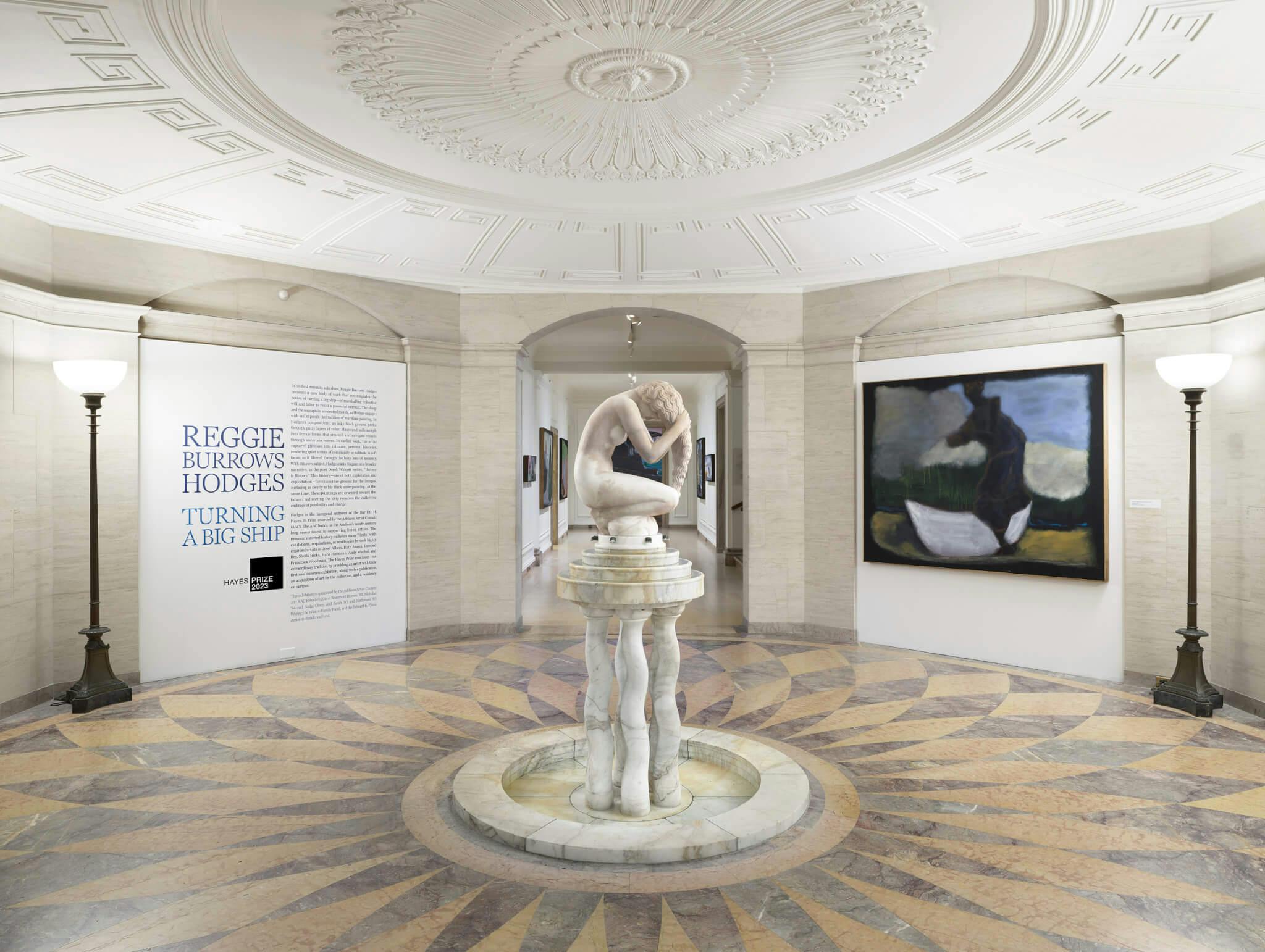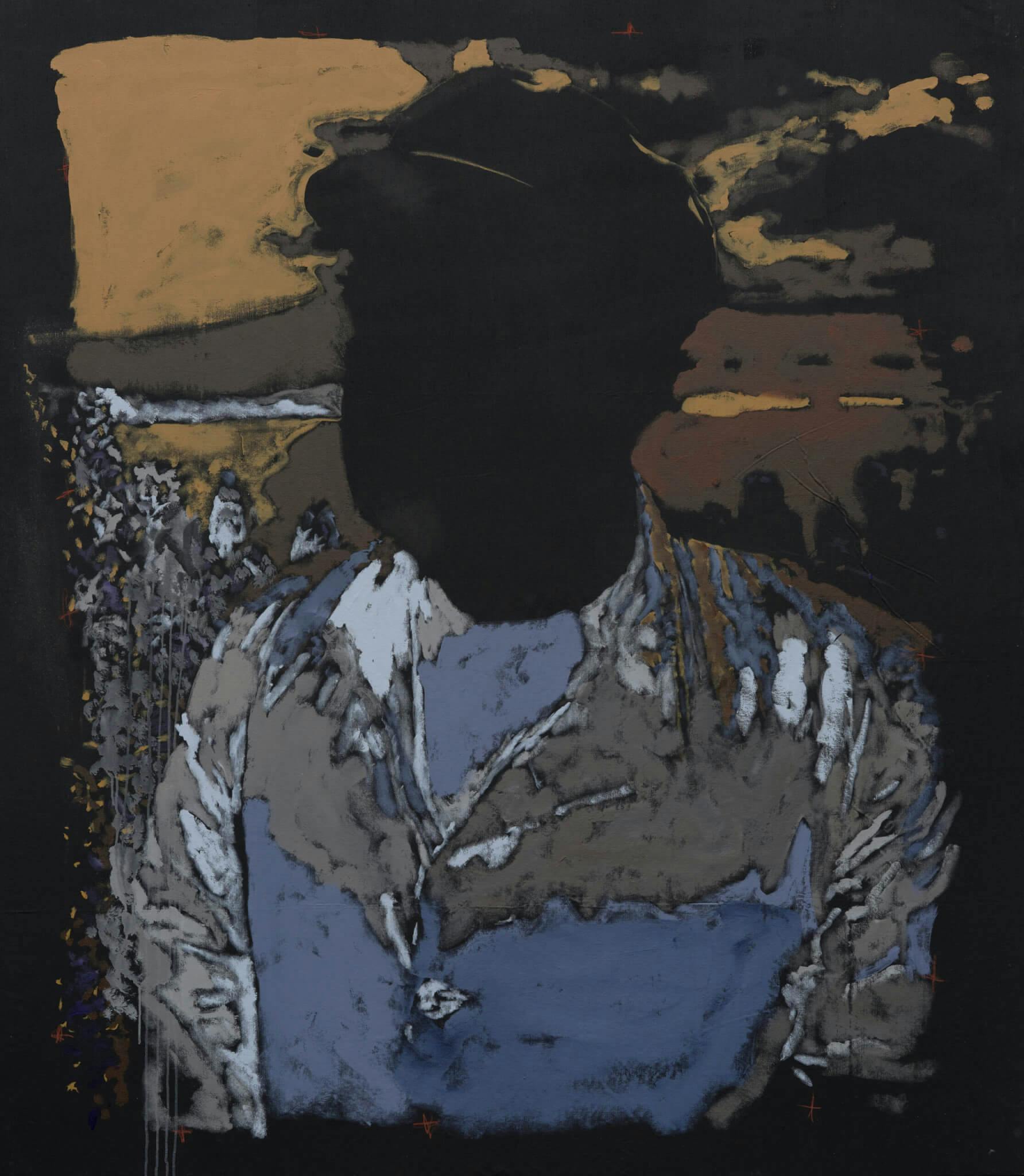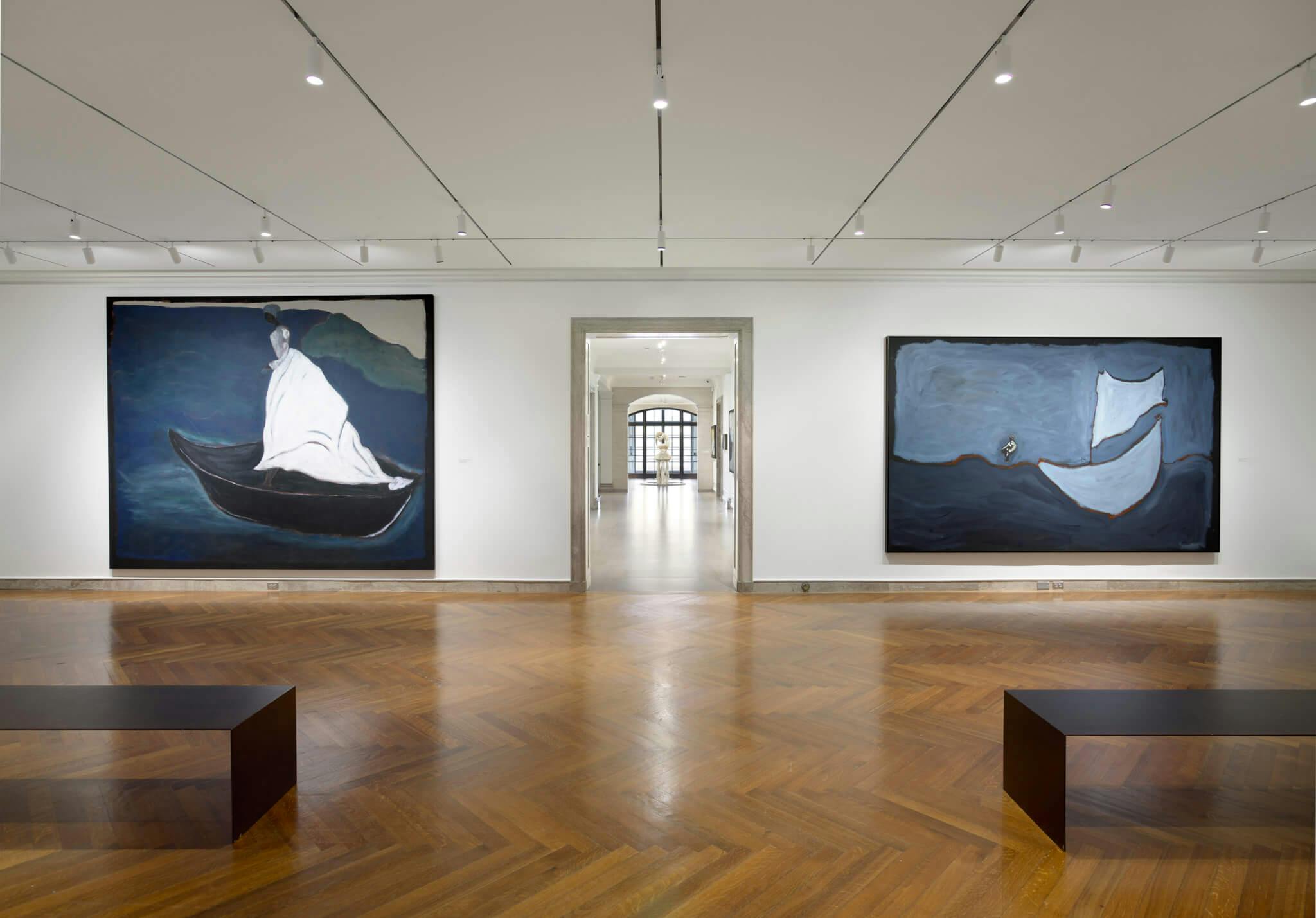“Turning a Big Ship,” painter Reggie Burrows Hodges’s solo exhibition of new work at the Addison Gallery of American Art at Andover’s Phillips Academy, marks the artist’s receipt of the Addison Artist Council’s inaugural Bartlett H. Hayes, Jr. Prize and his first solo museum show in a collecting institution. The prize recognizes Hodges’s “exceptional contributions to the continued exploration of the American experience,” and the nature of the Addison Gallery as a specific site reinforces this connection to a shared cultural language. With its original sections built in Neoclassical academic style in 1931, the building envelops the artwork on display in a distinctly American fantasy of personal elevation by way of traditional education and good manners. Hodges’s work leapfrogs over the conservative nature of this equation, positing a world in which ascension comes instead from an unorthodox degree of material directness, a willingness to open one’s heart to the beauty of change, and the ability to plumb emotional depths that reach deeper than the level of language.
The power of material to transform from everyday object to poetry through the alchemical mediation of the artist is at the heart of Hodges’s practice. His paintings are unapologetically physical. Painting with radiant, declarative opaque marks on a rich black ground, and using linen that continually announces its utilitarian origins, Hodges is known for his images of people in motion. The speeds of his figures vary, and sometimes contain meditative stillness, but, as in his approach to materials, there is always an undercurrent of embodied energy. His work rejects figurative painting’s potential for a meek retreat into recessive depth in favor of a powerful statement of emergent forward motion. The compositions advance into the spaces they inhabit like the light of sunrise moving into a darkened chamber.
In “Turning a Big Ship,” Hodges—who’s now based in California but lived for years in Maine—expertly harnesses this perceptual expansiveness, focusing on imagery that features a series of sloops (one-masted sailing ships), portraits of captains, and a few modern fishing boats and buoys. His canvas’s sail-like appearance is transmuted in this new series of work (comprising eighteen paintings created between 2022 and 2023), functioning as both container and character in his maritime narratives. The Sloop series is distinctive for its visionary imagery, in which the boats’ large triangular sails, filled with wind power and potential, transform into tall women who move forward in measured, confident steps. In Sloop: Inn Bound (soft pastel on linen, 2022) and Sloop: Eldaz Crossing (acrylic and pastel on canvas, 2022), large, elegant images of these sail-women rise to the surface of the black gesso like brilliant sea-flowers glowing beneath dark water. They form an inverse to Louise Bourgeois’s Femme Maison series, in which the woman is subsumed and erased by the structure of the house. Hodges’s sail-women have an incredible amount of power and agency as they stride forward in space to let the boat slip through the water at speed.
Similar poise and authority is found in his graceful, loosely rendered portraits of enormous sitting personages. See Captain: Alene, See Captain: Zorana, See Captain: Thala (all acrylic and pastel on linen, 2023), and See Captain: Nella (acrylic on linen, 2023) present these deity-scale figures alongside titles that give the viewer clues both clear and surprising. That these portraits represent monumental captains feels like a sensible progression from the Sloop paintings; to realize that they are women is revelatory, forcing us to confront our assumptions. The See Captain paintings are examples of Hodges’s practice of intuitive portraiture, in which he imagines his subjects into reality.
The intensity of Hodges’s marine-themed work is buttressed by its setting in the Addison Gallery itself. The adjoining show, “Sea Change,” features a suite of similarly ocean-themed artwork. This includes odd, lovely paintings that embody some of his experimental spirit, like Milton Avery’s Sea Gulls—Gaspé (oil on canvas, 1938). It also includes works such as Yinka Shonibare’s Wanderer (wood, plexiglass, fabric, and brass, 2006) that directly confront the narrative of the Middle Passage in their ship-based symbolism. That the imagery of ships is intimately entwined in this narrative for many Black artists is important, but subject to variation. The show’s title highlights the specific combination of struggle and hope that characterizes the atmosphere of this body of work. As Hodges explains, in “Turning a Big Ship” he is “proposing in a broader way the introduction of diaspora.” The reality of the Middle Passage is acknowledged, but a story of exploratory change, growth, and renewal is dominant; a sense of optimism and possibility emerges from his nautical women as they cross to a new shore.
Other story arcs related to “Turning a Big Ship” come from the Addison Gallery’s unusual collection of model ships, as well as its architectural specificity and institutional sculpture. The museum’s model ships appear throughout the building but mainly occupy lower-level corridors. Their uncanny, miniaturized, vitrine-protected precision as objects is in direct opposition to Hodges’s muscularity and embrace of large, generous, idiosyncratic gestures. Most of the models replicate clipper ships and other kinds of sailboats, but a model of the nineteenth-century sloop Puritan, built in 1932, offers a spare and graceful formal armature for the sail-women in Hodges’s work.
Upstairs in the museum’s foyer section, leading into the stately hallway and parquet-floored main gallery of “Turning a Big Ship,” a white marble fountain by Paul Manship dominates the circular space. Venus Anadyomene (marble, 1927) is a naked, crouching young woman perched at the top of a Modernist fountain dais, wringing out her hair with a gesture of apology. Directly in the background, Hodges’s Sloop: Mainland Revival (acrylic on linen, 2022) reverses this gesture. One of his graceful female figures, in old-fashioned dress and moving with equilibrium and purpose, steps into (or out of) a marble-pale boat. Her dark form merges with the undulating black boundary of the top edge of the composition, suggesting a fusion with the infinite.
In “Turning a Big Ship,” Reggie Burrows Hodges affirms the significance of his contribution to a conversation about American life, confronting the difficulty of the country’s layered histories with a narrative of dynamic movement and forward momentum.
“Reggie Burrows Hodges: Turning a Big Ship” is on view at the Addison Gallery of American Art through December 31, 2023.




